The Public Life of Sherlock Holmes: Holmes – Creation to Death and Back
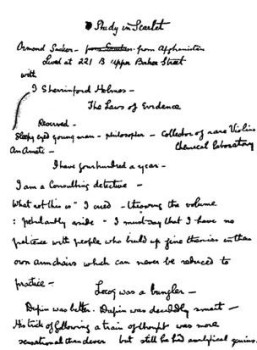 In 1882, Arthur Conan Doyle (not yet “Sir”) opened up his own shop as a doctor in Southsea (England). Business was slow and his most notable triumph was marrying the sister of a patient who died of meningitis.
In 1882, Arthur Conan Doyle (not yet “Sir”) opened up his own shop as a doctor in Southsea (England). Business was slow and his most notable triumph was marrying the sister of a patient who died of meningitis.
With some spare time on his hands, Doyle wrote fiction. Somewhere around 1886, he came to the conclusion that he could write detective stories better than the ones he was reading. He would create, “a scientific detective, who solved cases on his own merits and not through the folly of the criminal.”
Putting the pen to the paper, he completed A Study in Scarlet (working title, The Tangled Skein) that year. Originally starring Sherrinford Holmes and Ormond Sacker, the names had settled into the now familiar Sherlock Holmes and John Watson.
Doyle’s stories of Holmes owe a debt to Edgar Allen Poe that has been discussed by far better minds than mine. The now mostly forgotten Emile Gaboriau was also acknowledged by Doyle as an influence.
Mystery maven and Doyle biographer John Dickinson Carr stated that Holmes was clearly based on Doyle himself, which seems overly flattering.
Of course, Doyle said more than once that Joseph Bell, his instructor while at medical school in Edinburgh, was a significant basis for Holmes.
Ian Richardson (star of last week’s column) starred as Bell in the British television series, Murder Rooms. He played the Holmes-ish role while his Watson was actually a young Arthur Conan Doyle.
Hard to believe now, but nobody was interested in Sherlock Holmes at first. Doyle finally accepted a penurious offer of 25 pounds for the copyright and he was rebuffed when he asked for royalties (Doyle bitterly commented that he never made another penny off of that book).
Thirteen months later, it was published as part of Beeton’s Christmas Annual. It made little impact and Doyle moved on from Holmes.
In April of 1889, the editor of Lippincot’s American Magazine met with Doyle and Oscar Wilde, pursuant to establishing a British version of the publication. He commissioned Doyle to write The Sign of the Four while Wilde wrote The Picture of Dorian Gray.
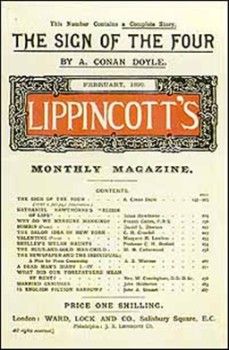 Doyle, who had been writing some well-received non-Holmes work since Study, was paid 100 pounds and retained the book rights. He took a break from writing his beloved The White Company to quickly write Sign.
Doyle, who had been writing some well-received non-Holmes work since Study, was paid 100 pounds and retained the book rights. He took a break from writing his beloved The White Company to quickly write Sign.
Possibly a lack of attention during this hurried writing resulted in the oft-discussed shifting of Watson’s war wound from his shoulder to his leg.
Sign of the Four wasn’t much more successful than A Study in Scarlet had been, possibly because large parts of both novels are flashbacks in which Holmes and Watson play no role. However, Doyle was about to hit on the form that would make Sherlock Holmes into fiction’s most enduring character.
The Strand was a new magazine and selling well. Doyle and its editor, Greenhough Smith, agreed on short stories featuring a recurring character, but not serials: they would be complete in each issue. That way, if someone missed an issue, they wouldn’t be lost.
In July of 1891, “A Scandal in Bohemia” appeared and Holmes’s popularity was sealed. Doyle had dashed off six short stories and was already tiring of Holmes. He asked for a significant increase to write six more: Greenhough Smith quickly agreed.
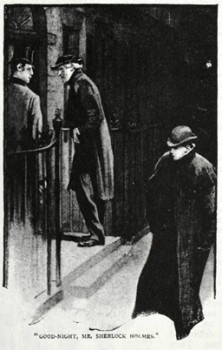 Those twelve stories were collected as The Adventures of Sherlock Holmes. The detective was extremely popular, but Doyle wanted to write more serious works and planned on killing him off in the twelfth story, telling his mother in a letter, “I think of slaying Holmes in the last and winding him up for good and all. He takes my mind from better things.”
Those twelve stories were collected as The Adventures of Sherlock Holmes. The detective was extremely popular, but Doyle wanted to write more serious works and planned on killing him off in the twelfth story, telling his mother in a letter, “I think of slaying Holmes in the last and winding him up for good and all. He takes my mind from better things.”
She replied with, “You won’t! You can’t! You mustn’t!” So he wrote “The Adventure of The Copper Beeches,” based on a plot she proposed and The Ma’am (what Doyle always called his mother) had saved Sherlock Holmes.
SPOILER ALERT. IF YOU’VE NOT READ “THE FINAL PROBLEM”, HOUND OF THE BASKERVILLES OR “THE EMPTY HOUSE”, SKIP TO THE END OF SPOILER ALERT.
However, Doyle was not to be talked out of offing Holmes for a second time and he tossed the detective off a ledge and into a waterfall in “The Adventure of The Final Problem” in December of 1893 (Merry Christmas!).
As he said in a letter to his mother while writing “Final Problem”, “All is very well down here. I am in the middle of the last Holmes story, after which the gentleman vanishes, never to return! I am weary of his name.”
Doyle, who filled up his time writing and lecturing, resisted calls to bring back Holmes until 1901: sort of. He certainly didn’t miss Holmes, writing in 1896, “I have had such an overdose of him that I feel towards him as I do towards pate de foie gras, of which I once ate too much, so that the name of it gives me a sickly feeling to this day.”
The first installment of The Hound of the Baskervilles appeared in August of 1901 and it was extremely successful. Doyle, still opposed to reviving Holmes, set the tale before “The Adventure of the Final Problem,” so that his detective was still officially dead.
But the toothpaste was out of the tube. Collier’s Weekly in America offered him a huge sum for six stories (or as many as he could write) and The Strand followed with a lesser but still sizable offer for the British rights.
Doyle would now be the highest paid author in the world and he pithily wrote to his agent, “Very well: ACD.”
“The Adventure of The Empty House” established unequivocally that Holmes was alive and well. It was the first of thirty-two short stories and one novel that Doyle would write about the great detective after The Hound of the Baskervilles.
END OF SPOILER
In a magazine article in 1900, Doyle wrote, “I knew I had done better work in other fields of literature, and in my opinion The White Company, was, for example, worth a hundred Sherlock Holmes stories…My lower work was obscuring my higher.” He goes in that vein, reminding me of Raymond Chandler’s condescending attitude.
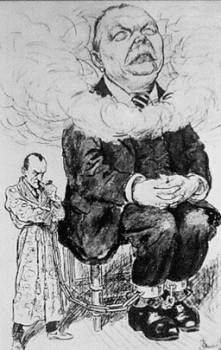 I’ve read a fair amount of Doyle’s works. Beyond Holmes, I’m not too much of a fan. I don’t consider his other works “better” than the Sherlock Holmes stories. And without Holmes, Doyle would be mostly forgotten today, as his next most popular character,
I’ve read a fair amount of Doyle’s works. Beyond Holmes, I’m not too much of a fan. I don’t consider his other works “better” than the Sherlock Holmes stories. And without Holmes, Doyle would be mostly forgotten today, as his next most popular character, Brigadier Gerard Professor Challenger (The Lost World), is not exactly a household name. Holmes was nothing short of a brilliant, revolutionary invention in the mystery field. There’s no diminishing his impact. But without Holmes, I wouldn’t be reading Doyle.
Sherlock Holmes made Sir Arthur Conan Doyle a rich man and a famous author. But he cast a shadow that the man never escaped. There was a famous cartoon in Punch magazine that I think captured the situation very well.
Hound Trivia – There is a conspiracy theory surrounding this famous story. Bertram Fletcher Robinson helped Doyle develop The Hound and it was originally dedicated to him (subsequent editions removed that dedication).
As Robinson brought Doyle to Devon and showed him around the area, the consensus is that he provided some of the inspiration and ambiance for the book, which was totally written by Doyle.
Around 2000, someone alleged that Doyle poisoned Robinson to cover up the fact that the author actually plagiarized The Hound: oh, and was having an affair with Robinson’s wife, who helped with the murder.
A court finally blocked an exhumation request and the matter has been put to rest for the non-conspiracy buff.
So, there you have the basics up to The Return of Sherlock Holmes.
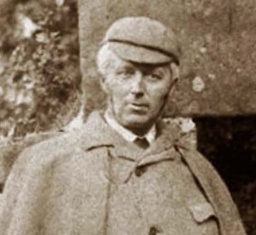
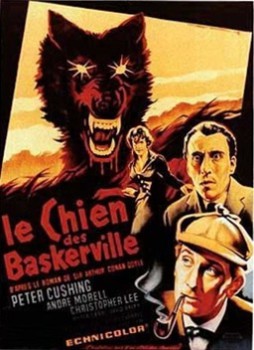
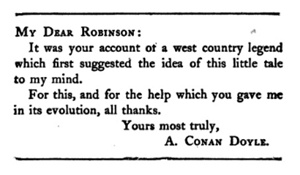
[…] Column #4 is up over at Black Gate. Here’s a sneak preview: […]
in 1975, Gene Wilder made the rather clever Holmes parody film, ‘The Adventures of Sherlock Holmes’ Smarter Brother.’
Sherrinford Holmes has been mentioned by Sherlockians (most notably William Baring Gould) as another brother; in addition to the ‘official’ one, Mycroft. And Sigerson was a name that Sherlock used while on his Great Hiatus after the showdown at The Reichenbach Falls.
So Wilder combines those two bits and is Sigerson Holmes (Sherlock’s younger brother) in this film, while his Watson is Orville Stanley Sacker, in a nod to Watson’s original name.
If you liked ‘Young Frankenstein’ this is the Holmes spoof for you.
Doyle was not alone in not liking his famous creation. Agatha Christie referred to her Belgian detective, Hercule Poirot, as a “detestable, bombastic, tiresome, ego-centric little creep.” Fortunately, in the battle of emotions, avarice won out over hatred and many Poirot tales flowed from her pen.
I just wanted to post to say how much I appreciate this series — great to have it at Black Gate!
That said, I will ask: wouldn’t Doyle’s second-most popular character, at least over most of the past century, be Professor Challenger? He’s made it into a number of movies, and one of his adventures actually named a genre (The Lost World). For what it’s worth, I feel Challenger’s actually entertaining enough on his own, but never really had the supporting cast of Holmes to throw him into relief. At any rate, I certainly agree with the broader point — Doyle’s other works are readable to varying degrees, but nothing like the Holmes stories.
Matthew: thanks! Yes, you’re right. I originally referenced the Lost World (I’ll point to anything with Claude Rains in it!) but somewhere along the way changed it to Gerard, which makes no sense. Probably just confused myself while reading the various bios. Doyle even dressed up as Challenger once: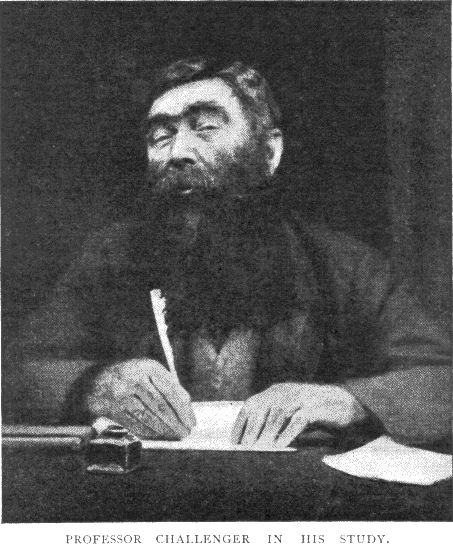
While Holmes is undoubtedly Doyle’s greatest creation, I do have a fondness for “The White Company.”
I enjoyed both ‘Sir Nigel’ and ‘The White Company’ but have little or no memory of them.
I’ve always been fascinated how money can bring out the best in some authors. ‘The Strand’ provided Doyle with the format – ie, short stories – and a considerable financial incentive to write them.* It’s unlikely Doyle would have chosen that format of his own accord, and apparently he complained that each story cost him as much effort as writing a book in terms of plotting. The thing is, the stories are much better than the books and the character of Holmes much better suited to a shorter format.
* I heard 1000 guineas, but a quick google indicates 480 – 620: still a great deal of money for the time.
I struggled through The White Company and gave up on Sir Nigel. Doyle tried so hard to present an “authentic” picture of the time, I found them dull.
The biographies indicate Doyle was the impetus behind the short story, recurring character approach. Funny thing is that’s what made Holmes so popular, yet Doyle spent the rest of his life resenting writing them.
Three of the novellas involve long flashbacks sans Holmes/Watson, and the other (Hound) has Holmes offstage for a huge chunk of the book. It’s as if Doyle didn’t know how to plot a long form Holmes tale entirely based on Holmes. Go figure.
There are several books on Doyle worth reading if you want to learn more ‘behind the scenes’ stuff: The Doctor and the Detective (Martin Booth), The Life of Sir Arthur Conan Doyle (John Dickinson Carr), The Man Who Created Sherlock Holmes (Andrew Lycett), Teller of Tales (Daniel Stashower) and Doyle’s own, Memories and Adventures.
Lycett’s is probably the best, though I enjoy Dickinson Carr’s quite a bit. The Doyle Estate gave him access to boxes of material, but he wasn’t allowed to be critical, so you have to take it with a grain of salt.
Mostly forgotten now, A.J. Raffles was a very popular ‘gentleman thief’ created by E.W. Hornung. Hornung had married Doyle’s sister. There have been several Raffles radio, tv and film projects as well as original stories and pastiches over the years.
Hornung and Doyle were on the outs for a time when the former dared to suggest that Doyle was being less than honorable to his ill wife by having a secret mistress (supposedly platonic). This went on for about a decade, until his wife died and Doyle married his long waiting girlfriend.
The nerve of Hornung…
Bob – I stand corrected! I never realised Doyle suggested the format to the magazine. Given that Holmes’ earlier incarnation had been via novels, and Doyle’s later antipathy to the stories, I always assumed the Strand approached Doyle.
Re the ‘Raffles’ stories. I heard Doyle wasn’t mad about them and said as much to Hornung, his argument being that embarking on a life of crime, no matter what your motives, was first step on the road to ruin. Naturally I’m open to correction….
Aonghus – The fact that we ended up with Holmes at all is pretty lucky.
First novel; over a year to be published and no splash at all. Not exactly a big start.
Second novel – a few years later and very little impact.
Doyle wasn’t enamored with mystery stories (like us avid readers) and could have simply given up on Holmes and continued with his other fiction and nonfiction. Fortuitous, indeed.
[…] Creation to Death and Back – A good intro to Holmes, focusing on Doyle’s love-hate (minus the love) relationship with his most famous creation […]
[…] As I discussed in an earlier post, with an almost non-existent medical practice on his hands, Doyle had some spare time and wrote A Study in Scarlet. Readers were introduced to the world’s first private consulting detective. Actually, very few people were. The story made no splash at all. An American magazine editor commissioned a second Holmes tale and Doyle dutifully dashed off The Sign of Four. Two long form stories and Holmes had quietly come and gone. […]